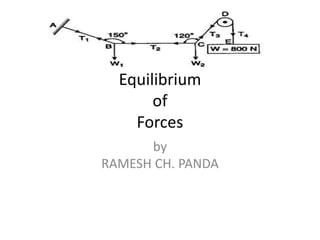
Equilibrium
- 2. PRINCIPLES OF EQUILIBRIUM 1. Two force principle. As per this principle, if a body in equilibrium is acted upon by two forces, then they must be equal, opposite and collinear. 2. Three force principle. As per this principle, if a body in equilibrium is acted upon by three forces, then the resultant of any two forces must be equal, opposite and collinear with the third force. 3. Four force principle. As per this principle, if a body in equilibrium is acted upon by four forces, then the resultant of any two forces must be equal, opposite and collinear with the resultant of the other two forces.
- 3. METHODS FOR THE EQUILIBRIUM OF COPLANAR FORCES • 1. Analytical method. • 2. Graphical method.
- 5. LAMI’S THEOREM It states, “If three coplanar forces acting at a point be in equilibrium, then each force is proportional to the sine of the angle between the other two.”
- 6. PROOF OF LAMI’S THEOREM
- 7. Example1 An electric light fixture weighting 15 N hangs from a point C, by two strings AC and BC. The string AC is inclined at 60° to the horizontal and BC at 45° to the horizontal as shown in Fig
- 8. SOLUTION
- 9. Example 2 A string ABCD, attached to fixed points A and D has two equal weihts of 1000 N attached to it at B and C. The weights rest with the portions AB and CD inclined at angles as shown in Fig.
- 10. SOLUTION
- 11. Example 3 A light string ABCDE whose extremity A is fixed, has weights W1 and W2 attached to it at B and C. It passes round a small smooth peg at D carrying a weight of 300 N at the free end E as shown in Fig.
- 12. SOLUTION
- 13. Example 4 A smooth circular cylinder of radius 1.5 meter is lying in a triangular groove, one side of which makes 15° angle and the other 40° angle with the horizontal. Find the reactions at the surfaces of contact, if there is no friction and the cylinder weights 100 N.
- 14. Example 5. Two cylinders P and Q rest in a channel as shown in Fig. The cylinder P has diameter of 100 mm and weighs 200 N, whereas the cylinder Q has diameter of 180 mm and weighs 500 N. If the bottom width of the box is 180 mm, with one side vertical and the other inclined at 60°, determine the pressures at all the four points of contact.
- 15. SOLUTION
- 17. CONDITIONS OF EQUILIBRIUM 1. The body may move in any one direction. 2. The body may rotate about itself without moving. 3. The body may move in any one direction and at the same time it may also rotate about itself. 4. The body may be completely at rest.
- 18. CONDITIONS OF EQUILIBRIUM Σ H = 0 Σ V = 0 and Σ M = 0
- 19. TYPES OF EQUILIBRIUM • 1. Stable equilibrium 2. Unstable equilibrium • 3. Neutral equilibrium
- 20. 1. Stable equilibrium A body is said to be in stable equilibrium, if it returns back to its original position, after it is slightly displaced from its position of rest.
- 21. 2. Unstable equilibrium A body is said to be in an unstable equilibrium, if it does not return back to its original position, and heels farther away, after slightly displaced from its position of rest.
- 22. 3. Neutral equilibrium A body is said to be in a neutral equilibrium, if it occupies a new position (and remains at rest in this position) after slightly displaced from its position of rest.
- 23. QUESTIONS